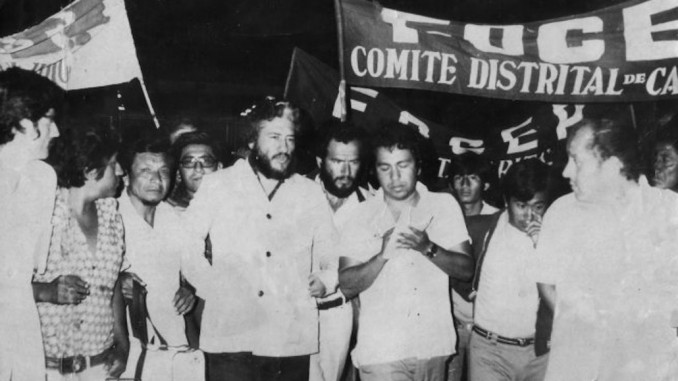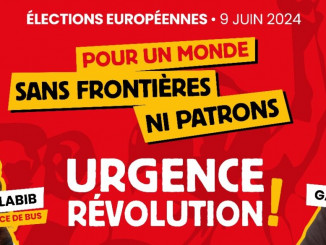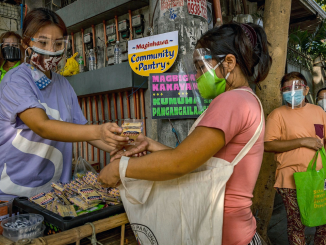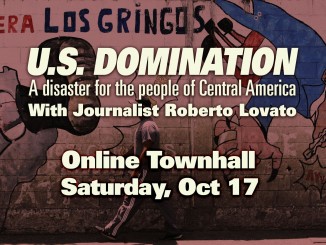
Hugo Blanco, one of the greatest revolutionary figures in South American history, has passed away after a lifetime of struggle. Blanco was born in Cusco, Peru, the province where the ancient capital of the Inca empire was located, and the center of indigenous resistance in Peru from the time of the Spanish conquest to the present.
Hugo Blanco became a revolutionary as a young student in Argentina. He began his activist life as an organizer among meat-packing workers. He then joined the Trotskyist movement – the revolutionary movement of the working class that held true to the ideals of democracy for the exploited, the possibility of a transformation of society on a world scale, and the leading role of the working class in bringing about that transformation.
After learning how to organize in the workplace and forming his political perspective, he returned to Lima, Peru to spread the movement and build a revolutionary workers’ organization in his native country. In 1958, shortly after his arrival, his organization, the Revolutionary Workers Party, was banned for leading a demonstration against the visiting U.S. Vice President Richard Nixon. Blanco took refuge in the Convencion Valley, in his home province of Cusco. There, while active in the newspaper-sellers’ union, he came into contact with indigenous peasant communities struggling against starvation while rich landowners monopolized the croplands. The “hacienda” system, common to Peru, Bolivia, and other South American countries, was a system of sharecropping in which big land owners rented small plots of land to peasants in return for most of the profits, treating them with extreme brutality. The peasants suffered tremendously, and their anger was reaching a boiling point.
Blanco saw the possibility to organize the peasantry for a struggle. He was from Cusco, and though he had been raised in a middle-class family, he was fluent in the indigenous Quechua language spoken by the Peruvian peasants. As a worker-revolutionary, Blanco found himself operating on a new terrain – in rural communities assisting the peasants in their struggle for land. In order to share the life of the peasantry and be able to relate to their struggle as an equal, he became a tenant farmer himself. From 1958-1963, Blanco led the Department Federation of Cusco Peasants (FDCC). They formed armed brigades and seized hacienda lands without compensating the landowners. He was called “the Che Guevara” of Peru, and received salutations from the Cuban revolutionaries. The armed struggle Blanco helped lead and his charismatic leadership seemed to parallel the revolution taking place simultaneously in Cuba.
However, Blanco stressed the differences of the movement he led with that of the Cuban revolutionaries. The FDCC were not a guerrilla army aiming to take control in the name of the peasants. The territories seized by the FDCC were governed by a direct democracy, the model of a society directed by the exploited themselves. The territories they seized were governed by elected and re-callable delegates. The armed brigades were composed of the peasants themselves, and controlled only by them. This was a marked difference from the guerrilla model of the Cuban Revolution in which the revolutionary army was independent of any popular control and democracy played little to no part in the governance of Cuba following the revolution.
In 1962, Blanco was captured by the Peruvian military and sentenced to 25 years in prison. The FDCC responded by taking over the city of Quillabamba. The occupation lasted for months, and demanded an end to the hacienda system and the release of Blanco and his comrades from the Revolutionary Workers’ Party and the leaders of the FDCC. The occupation failed to win freedom for the FDCC leaders, but it still led to a major victory. The repressive hacienda system was abolished in the Convencion Valley. Peasants all across the highlands of Peru saw the example and began their own land occupations. Finally the government of General Velasco was forced to carry out an agrarian reform program to placate the peasants and head off further growth of the movement. With its main demands won, the FDCC eventually demobilized and the peasant struggle for land division came to a successful end.
Hugo Blanco remained in prison for eight years, during which an international campaign was carried out to free him. In 1970, he was deported to Mexico, then lived in Argentina, then Chile, then Sweden. In 1978, Blanco won the right to return to Peru. There, he re-formed the Revolutionary Workers’ Party and was elected to parliament. In 1980, Blanco ran as the lead candidate of a coalition of left-wing parties, the Workers, Peasants, and Students Front (FOCEP), winning 12 percent of the vote. In these elections, Blanco ran openly as a revolutionary, arguing that the working class had to fight in its own name, and link its struggle with that of the indigenous peasantry, to make a revolution and transform Peru as one step towards overthrowing capitalism the world over. Though he had been a peasant leader, Blanco always maintained the Trotskyist stance that the working class held the most important power to transform society. Without a working class that could challenge the power of the capitalist system directly, in the workplaces and on a larger scale, the struggles in rural Peru would be limited to reforms or limited victories – as in Cusco’s Convencion Valley.
From 1990-1992, Hugo Blanco was once again elected senator, though he lost his seat when the dictator Alberto Fujimori came to power and dissolved the congress. Since that time, Blanco was in exile in Mexico, or in Sweden, where his family had settled. Nevertheless, he continued his political engagement, although by this point he had abandoned the Trotskyist position. However, he always maintained his revolutionary convictions, arguing that capitalism must be overthrown and only a democratic revolution led by the oppressed themselves could do it. He argued – rightly – that this is an immediate and imperative necessity due to the ecological damage capitalism is doing to the world.
It is an honor that the working-class revolutionary movement, Trotskyism, could produce such a historic leader of peasant struggle. The limitations of that peasant struggle in the Convencion Valley were well-understood by Blanco himself. But revolutionaries don’t get to choose where and when they are active. Blanco was right to engage with the peasants, knowing that their struggle was an important one, and that they may also have had relationships with working-class friends and relatives in the big cities and mining communities of Peru.
Every oppression and exploitation in capitalist society leads back to the same source – the capitalist class and its system, whether we are talking about the owners of land, mines, factories, or tech firms. For this reason, working-class revolutionaries don’t stand aside from or ignore any struggles of the oppressed. As Blanco understood, a revolutionary transformation of society demands that those in the struggle make their own decisions and control their own organizations. No liberating saviors, no matter how well intentioned, can free us. It is up to us to fight for participation and democracy everywhere we are active, and to explain the nature of this society and the need to transform it. No matter where or how he was active, this is the perspective that Hugo Blanco fought for. Let’s remember his life by carrying forward the same perspective, understanding as he did, that it is a necessity today more than ever.




